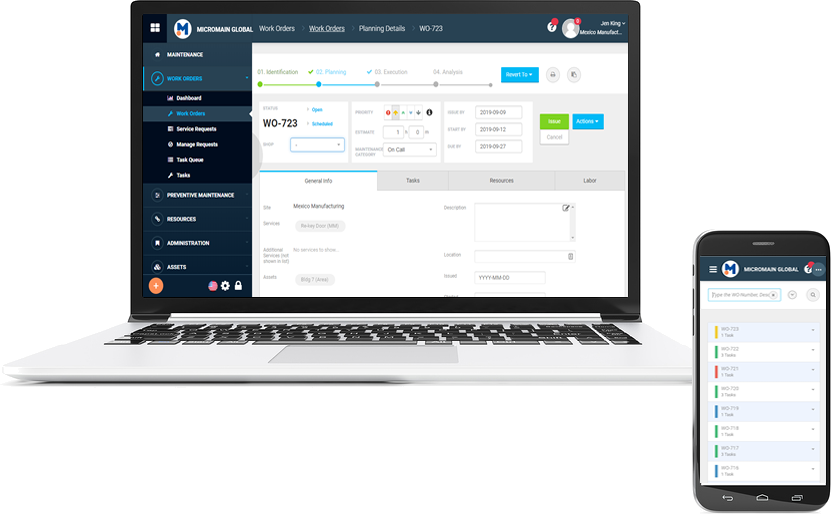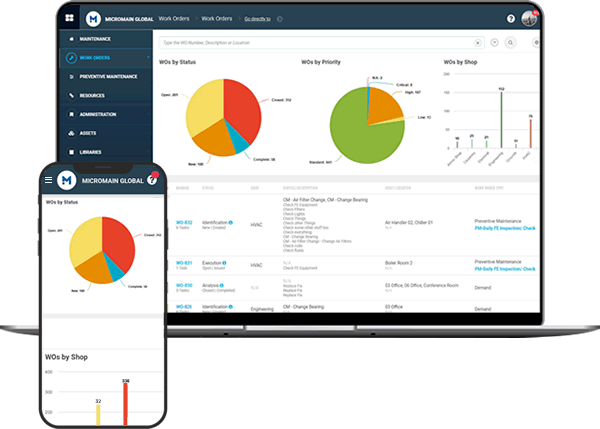Do you remember when a production line stopped due to equipment failure and the frantic, costly hours or even days spent fixing it? Or you may have too much inventory cluttering your storeroom because you need to know precisely what is necessary for your regular maintenance tasks. Every maintenance manager in the manufacturing industry has experienced these pain points.
Preventive maintenance software is the knight in shining armor to tackle these problems head-on. Instead of being reactive to equipment failures, such a platform allows maintenance managers to be proactive, mitigating breakdown risks, optimizing part use, and planning work more efficiently.
We have to admit preventive maintenance inevitably involves some startup costs. However, consider this - unplanned downtime can cost businesses an average of $260,000 per hour! Quite a number, isn't it? By contrast, preventive maintenance could result in substantial long-term savings, a smoother production process, and improved overall operational efficiency.
Quick Takeaways
- MicroMain's CMMS and EAM Software: A comprehensive solution that offers preventive maintenance, work order management, labor tracking, and more.
The mission of our roundup is to guide you through the leading preventive maintenance software options in 2024 and help you find the one that best fits your unique needs. So, buckle up as we embark on this journey into the world of preventing emergency maintenance situations and improving your maintenance operations overall.

Understanding Preventive Maintenance
Equipment failure in manufacturing and industrial operations can lead to significant productivity losses and unexpected costs. This is where preventive maintenance comes in.
Definition of Preventive Maintenance
Preventive maintenance is a proactive approach to managing the upkeep of machinery and equipment. It involves scheduled routine tasks aimed at preventing equipment deterioration or failure. The primary goal is to keep your assets in good working condition, minimizing downtime and extending the lifespan of your equipment.
Importance of Preventive Maintenance
The relevance of preventive maintenance must be balanced. Staying on top of maintenance tasks can prevent unplanned downtime, saving the company time and money. It also takes administrative duties off technicians' shoulders, allowing them to focus better on their jobs. Moreover, a well-implemented preventive maintenance plan decreases the risk of safety incidents caused by ill-maintained machinery.
Types of Preventive Maintenance: Time-based and Usage-based
There are two primary types of preventive maintenance: time-based and usage-based.
Time-based preventive maintenance is scheduled at regular intervals, such as quarterly or annually. It's akin to getting your car serviced every few thousand miles.
On the other hand, usage-based preventive maintenance considers the average daily usage of a machine to forecast due maintenance. For instance, if a machine runs for a certain number of hours, it triggers a preventive maintenance task.
It's worth noting that the preventive maintenance method you choose depends on the nature of your equipment and overall operational strategy.
Preventive Maintenance Tasks: Cleaning, Oil Changes, Inspections, Lubrication, and Parts Replacement
Preventive maintenance tasks could range from simple to complex, depending on the type of equipment and its usage. These include cleaning surfaces, changing oil, inspecting for potential issues, lubricating gears, or replacing worn-out parts.
An efficient preventive maintenance software like MicroMain's CMMS can streamline these tasks, ensuring that nothing falls through the cracks and your equipment runs smoothly.
In the next section, we'll delve into the role of preventive maintenance software and how it can be a game-changer for your maintenance operations.
The Role of Preventive Maintenance Software
No matter the size of your organization, keeping track of maintenance tasks can be a complex process. This is where preventive maintenance software comes into play, simplifying the process and ensuring your maintenance operations run smoothly.
What is Preventive Maintenance Software?
Preventive maintenance software is a specialized tool designed to manage all aspects of preventive maintenance within an organization. It conveniently stores all your maintenance data in one place, allowing you to track inspections, repairs, and replacements quickly. It's like a digital assistant that helps coordinate all your preventive maintenance tasks, minimizing disruption to the work schedule when maintenance is performed.
Benefits of Using Preventive Maintenance Software
The advantages of implementing preventive maintenance software are numerous. First, it helps lower operational costs by reducing machine downtime and costly reactive repairs. It also increases productivity by enabling better work planning and scheduling, ensuring tasks can be completed faster.
Furthermore, preventive maintenance software aids in increasing the lifespan of your equipment by preventing breakdowns and addressing potential issues before they occur. This, in turn, improves safety in your workplace by minimizing machine breakdowns.
But that's not all. It also allows you to maintain accurate historical data for each piece of equipment, which can be invaluable for audits, inspections, and making informed future maintenance decisions.
Key Features to Look for in Preventive Maintenance Software
When considering different preventive maintenance software options, there are a few key features you should look out for:
1. Preventive Maintenance Scheduling: The software should allow you to create a maintenance schedule for each piece of equipment, outlining all required inspections and preventive maintenance tasks.
2. Work Orders: Work orders are the backbone of preventive maintenance, so your software should be able to create, track, and manage them effectively.
3. Reporting Capabilities: Good software should allow you to create various reports to spot trends and pinpoint areas for improvement.
4. Checklists: Access to checklists within the software helps ensure that each preventive maintenance task is completed and noted.
5. Mobile Usability: Technicians should be able to access the software on a mobile device. This allows for real-time updates on the status of work orders and access to maintenance checklists no matter where they are.
Remember, the best preventive maintenance software is the one that fits your organization's unique needs and workflows. Whether you're a small business or a large manufacturing company, effective preventive maintenance software can significantly improve your maintenance operations and bottom line.
Next, discuss creating a preventive maintenance plan that suits your organization's needs.
Creating a Preventive Maintenance Plan
Creating a preventive maintenance plan involves a series of steps that require careful thought and collaboration. This plan is critical for any organization as it helps in the smooth operation of all equipment, reducing the risk of unexpected breakdowns and costly repairs.
Involving the Right People
The first step in creating a preventive maintenance plan is to get the right people on board. This includes top management and any staff member who understands how the company's maintenance department operates. These individuals should be actively involved in decision-making, as their insights can significantly impact the plan's effectiveness.
Establishing Goals
Before you start creating the plan, it is essential to identify the end goal. Both short-term and long-term goals should be established at the beginning. Goals may include decreasing downtime by a certain number of hours or reducing reactive repair costs by a certain percentage. Clear goals will guide the entire planning process and ensure the plan is aligned with the organization's objectives.
Inventorying Equipment
Next, create a comprehensive inventory of all equipment. This inventory should include all relevant information, such as serial numbers, specifications, and the equipment's current condition. This step is crucial as it helps identify and prioritize equipment that requires preventive maintenance.
Determining Maintenance Frequency
Not all machines will need the same amount of maintenance. Decide what type of preventive maintenance is required for each piece of equipment. The frequency of maintenance can be determined based on usage or elapsed time. For instance, an oil change might be necessary every three months or after every 3,000 miles, whichever comes first. If you need clarification on the maintenance frequency, check with the manufacturer for their recommended procedures.
Considering Timing and Labor
When setting the frequency, consider if the preventive maintenance tasks should be generated in advance to allow time to gather and order parts. Also, spread out the timing of the work orders to avoid all due on the same day. Consider the labor time and include the estimated time to complete each task so workers can better plan their day.
Ensuring All Equipment is Covered
Start with the most critical equipment and identify what should be done weekly, monthly, annually, etc. Once the critical ones are set up, start at the beginning of a production line and work to the other end. For facility maintenance, go floor by floor and room by room. This step ensures that every piece of equipment is included in the preventive maintenance plan.
Providing Training
Proper training is essential for all maintenance personnel who will be completing the preventive maintenance tasks. If preventive maintenance software is used, ensure everyone is familiar with it. Repeat training to ensure that all personnel are updated with the latest procedures.
Measuring Effectiveness
It's essential to measure the effectiveness of your preventive maintenance plan consistently. This can be done by tracking key performance indicators (KPIs) such as equipment downtime, repair costs, and the number of emergency repairs. Regularly reviewing these metrics will help you identify areas for improvement.
Regularly Reviewing and Updating the Plan
A preventive maintenance plan is not a set-and-forget strategy. It requires regular reviews and updates based on the changing needs of your organization and the condition of your equipment. Regular inspections ensure that your plan remains effective and continues to provide value to your organization.
A comprehensive preventive maintenance plan is crucial to efficient and cost-effective asset management. Organizations can significantly improve their maintenance operations and bottom line by involving the right people, setting clear goals, and regularly reviewing and updating the plan.
Tracking Preventive Maintenance
Having a preventive maintenance plan in place is one thing. Ensuring its effective implementation and tracking its progress is quite another. This is where the role of a Computerized Maintenance Management System (CMMS) with preventive maintenance software comes into play.
The Role of a Computerized Maintenance Management System (CMMS) with Preventive Maintenance Software
A CMMS with preventive maintenance software is a centralized database for all maintenance-related tasks and activities. It allows maintenance managers to schedule technician job tasks, monitor equipment conditions, and generate comprehensive reports for analysis.
In essence, a CMMS simplifies what used to be a complex process of tracking maintenance activities. Instead of relying on spreadsheets or hand-written papers, maintenance data is stored on a computer (or in the cloud) for easy access and tracking. This includes inspections, repairs, replacements, work orders, purchase orders, and inventory. The software even prioritizes maintenance tasks based on operations, minimizing disruptions to the work schedule when maintenance is performed.
Benefits of Using a CMMS for Tracking Preventive Maintenance
The benefits of using a CMMS for tracking preventive maintenance are numerous. Here are a few key advantages:
Efficiency: With all data conveniently stored in one place, our preventive maintenance software effectively manages maintenance records, helping operations run smoothly.
Cost Savings: The system can plan and prioritize maintenance tasks based on operations, minimizing the disruption to the work schedule when maintenance is performed. This, in turn, leads to savings in maintenance costs.
Focus on Core Tasks: Preventive maintenance software takes administrative duties off technicians' shoulders, allowing them to focus better on their jobs.
Audit Readiness: Since the checklist answers are electronically tracked and can be reported on, they can be used for audit purposes or trending analysis. It also reduces the amount of work needed in periodic audits.
Performance Improvement: By learning about these and other essential benefits a CMMS offers, businesses can reduce maintenance costs while improving performance and efficiency.
In conclusion, utilizing a CMMS with preventive maintenance software is not just a nice-to-have but a must-have for businesses wanting to improve their overall maintenance operations. It is a powerful tool that turns complex maintenance processes into manageable tasks, contributing to significant cost savings and improved operational efficiency.
In the next section, we'll dive into the top preventive maintenance software options for 2024, including our own industry-leading CMMS software at MicroMain.
Conclusion
Recap of the Importance of Preventive Maintenance and the Role of Software
To sum up, preventive maintenance is crucial for any manufacturing industrial company. It helps maintain equipment in optimal condition, reduces the risk of unexpected failures, and extends the lifespan of your machinery. It's all about being proactive rather than reactive to prevent costly downtime and ensure smooth operations.
The central player in effective preventive maintenance is undoubtedly the preventive maintenance software. As discussed, this software simplifies otherwise complex processes by efficiently managing and tracking all maintenance tasks. It stores all your company's maintenance data in one place, making it easy to keep track of inspections, repairs, replacements, and work orders. In addition, it helps technicians prioritize tasks and collect necessary information, improving their productivity and focus.
Final Thoughts on Choosing the Best Preventive Maintenance Software for 2024

Choosing the proper preventive maintenance software for your company is a significant decision. It's not just about selecting a tool; it's about investing in a solution that will streamline your operations, reduce costs, and ultimately contribute to your bottom line.
When making this decision, consider the unique needs of your organization. Do you operate complex machinery that requires frequent maintenance? How big is your maintenance team? What is your overall maintenance budget? Answering these questions will help you identify the software that best aligns with your operational needs and financial capabilities.
Remember, the best preventive maintenance software for your company is the one that offers the right balance between cost, functionality, ease of use, and scalability. It should also come from a trusted provider, like us at MicroMain, with a proven track record of delivering reliable, industry-leading CMMS and EAM software solutions.
Finally, take into account the value of vendor support and training. The right preventive maintenance software comes with comprehensive training and ongoing support to ensure your team can use it effectively and maximize its capabilities.
And there you have it! We hope this guide has been helpful in your search for the best preventive maintenance software for 2024. Remember, preventive maintenance is a journey, not a destination. It's a continuous improvement process; the right software will be your ally on this journey.
Explore our other resources, such as our predictive and proactive maintenance, for more in-depth knowledge about preventive maintenance and CMMS solutions.
 For immediate assistance, please call us at (512) 328-3235
For immediate assistance, please call us at (512) 328-3235



